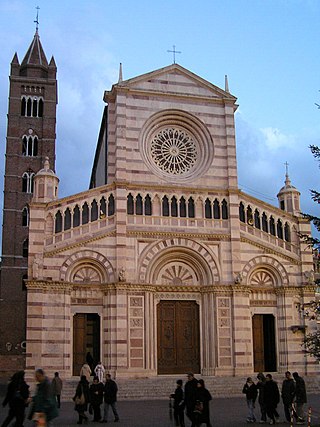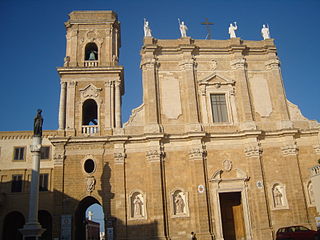Atella was an ancient Oscan city of Campania, located 20km directly north of Naples.

The Archdiocese of Florence is a metropolitan see of the Catholic Church in Italy. It was traditionally founded in the 1st century, according to the 14th century chronicler Giovanni Villani. The diocese was directly subordinate to the Holy See (Papacy) until 1420.

The Roman Catholic Archdiocese of Capua is an archdiocese of the Roman Catholic Church in Capua, in Campania, Italy, but its archbishop no longer holds metropolitan rank and has no ecclesiastical province. Since 1979, it is a suffragan of the Archdiocese of Napoli, i.e. no longer has its own ecclesiastical province nor metropolitan status.

The Diocese of Rimini is a Latin Church ecclesiastical territory or diocese of the Catholic Church in Emilia Romagna, Italy. From earliest times, it was a suffragan to the Holy See, despite repeated attempts by the Diocese of Ravenna to claim it as a suffragan diocese. Since 1604, however, it has been a suffragan of the Archdiocese of Ravenna-Cervia.

The Roman Catholic diocese of Ferentino existed until 1986, when it was united into the new diocese of Frosinone-Veroli-Ferentino.

The Diocese of Grosseto is a Roman Catholic ecclesiastical territory in Italy, a suffragan of the archdiocese of Siena-Colle di Val d'Elsa-Montalcino, in Tuscany. Its current bishop is Giovanni Roncari, OFMCap.

The Archdiocese of Siena-Colle di Val d'Elsa-Montalcino is a Roman Catholic archdiocese in Tuscany. The seat of the archbishop is the Cathedral of the Assumption in Siena. Until 1459, the diocese was immediately subject to the Holy See (Papacy), and its bishops attended the Roman synods. In 1459, Pope Pius II made Siena a metropolitan archbishopric.

The Diocese of Tolentino was a Roman Catholic diocese in Italy in the fifth century and early sixth century. The name of the diocese was revived, and its territory added to the Diocese of Macerata-Tolentino in 1586 by Pope Sixtus V.

The Archdiocese of Pisa is a metropolitan see of the Catholic Church in Pisa, Italy. It was founded in the 4th century and elevated to the dignity of an archdiocese on 21 April 1092 by Pope Urban II. The seat of the bishop is the cathedral of the Assumption in the Piazza del Duomo.

The Italian Catholic diocese of Todi existed until 1986, when it was united into the diocese of Orvieto-Todi. Up until that point, the diocese had always been directly dependent on the Holy See.

The Italian Catholic Diocese of Cesena-Sarsina in Emilia Romagna was created on September 30, 1986, after the Diocese of Sarsina was united with the historic Diocese of Cesena as a suffragan of the Archdiocese of Ravenna-Cervia.

The Italian Catholic Archdiocese of Brindisi-Ostium in Apulia, has carried its present name since 1986. It is a suffragan of the archdiocese of Lecce.

The Diocese of Anagni-Alatri is a Latin Church ecclesiastical territory or diocese of the Catholic Church in Lazio, Italy. It has existed in its current form since 1986. In that year the Diocese of Alatri was united to the historical Diocese of Anagni. The diocese is immediately exempt to the Holy See.
The Diocese of Tuscanella was a Latin Church residential bishopric of the Catholic Church, in existence by the 7th century. Even at the time of the Lombard invasions, it belonged to the Duchy of Rome and was immediately subject to the Pope. The seat of the bishop was originally in the church of S. Maria, then in the church of S. Pietro, and after 1592 in the church of S. Giacomo.

The Council of Pisa was a controversial ecumenical council of the Catholic Church held in 1409. It attempted to end the Western Schism by deposing Benedict XIII (Avignon) and Gregory XII (Rome) for schism and manifest heresy. The College of Cardinals, composed of members of both the Avignon Obedience and the Roman Obedience, who were recognized by each other and by the Council, then elected a third papal claimant, Alexander V, who lived only a few months. He was succeeded by John XXIII.

The Council of Perpignan, which was intended to be a general council of the entire Catholic Church, was convened in November 1408, by Pope Benedict XIII of the Avignon Obedience. The site of the council was the city of Perpignan, which belonged to the Crown of Aragon, which was still in the Avignon Obedience after the withdrawal of French support from Benedict XIII in 1408.
Eutychius of Vienne was a 6th century bishop of the Roman Catholic Archdiocese of Vienne in France. Very little is known of his career, except his was time of expansion for Christianity in the early French Kingdom. He was a signatory of the Fifth Council of Orléans
Aré or Aregius of Nevers was bishop of Nevers in France and is known because he subscribed to the deeds of both the Fifth Council of Orléans, in 549 and the Second Synod of Paris in 551.
Bishop Agricola was a 6th-century Bishop of Chalon-sur-Saône in France.
Vitalis of Albano was a Cardinal and bishop of Albano.













